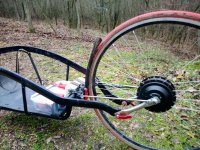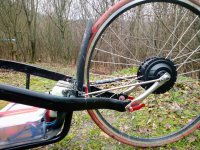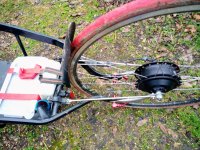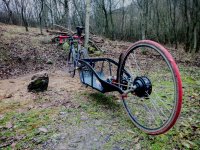51owRider said:
Of course, safety first. I'm fairly proficient programming microcontrollers, the wireless will be over BLE on an ESP32 with a short timeout and will give the controller a PWM signal simulating a throttle potentiometer. I've built some powermeters and cyclocomputers on the ESP, for anyone interested: https://github.com/gsoros/ESPM and https://github.com/gsoros/ESPCC .
Thanks--maybe at some point I could conscript you

to help with some little projects here and there like the Nano Tidbits stuff when I eventually get back to those (and one relatively large (to me) robotics-related project that I am still working out what it has to do exactly).
51owRider said:
Good point. Although, the dropouts are quite thick, I could lay down some hefty over-engineered beads, but it's probably safer to find someone with a big enough kiln.
I'm not experienced at anything other than steel-welding (and certainly no expert at that

), so I don't know if that will compensate for the change in strength of the areas around the weld itself (I don't know how large the HAZ would be, but I expect fairly big given the capacity of aluminum to quickly re-distribute heat).
It's an oddly shaped thin-wall hollow-section, don't think clamping is a good idea. I could drill it and use rivnuts, also not ideal for structural stuff... I'll think about it.
I used hose clamps to secure thinwall aluminum tubing ex-sleeping-cot sections together to keep the SB Cruiser's canopy in position against all the gusty winds and whatnot it experiences, and the cantilevering torque. It's also got bolts thru the tubes into the rear over-cargo-deck frame made of the rest of the cot. It works, and doesn't loosen, but I don't expect it sees the same loads yours will.
However, if the clamps are of sufficient surface area, and there are enough of them, they'll distribute the load over enough tubing to reduce the risk of any damage to any specific areas. Myself, I don't think it's a risk, but I dont' have your trailer there to examine, and I am not a mechanical engineer (just an experienced hack with decades of (mostly) successfully misusing things for other purposes behind me :lol: ).
My personal experience with rivnuts in things other than just securing non-structural cover plates to "boxlike structures" has been less than stellar, whether they were preinstalled or I did them, but that's just as likely to be a user problem as a design/materials one.
Thanks and please give a Jelly Bean a good belly rub from me.
Jelly Bean the Belly Bean will appreciate that. She's presently upside down at the end of the bed snoozling...











![strip_a9535a95b84a4d264a5d3eb711d5ba1a5d74ab1e[1][1].jpg strip_a9535a95b84a4d264a5d3eb711d5ba1a5d74ab1e[1][1].jpg](https://endless-sphere.com/sphere/data/attachments/190/190260-c2e1b27b0d088ed8c9c2e5df3915be91.jpg)